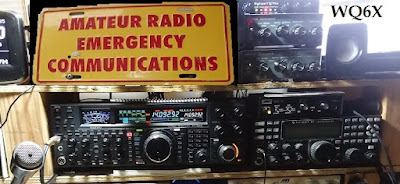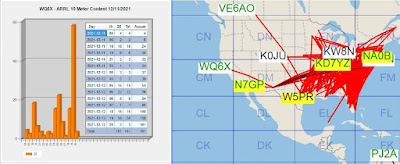This last weekend was "Touch and Go" regarding the ARRL Dx Phone Contest. In years past,
I have run the DX contest events solo, even once remotely from Stateline Nevada. This year thinking nobody would mind, N6KI gave me the go-ahead to single-OP the Dx contest if nobody else wanted to operate. A group email from Dennis elicited several thumbs-UP responses to operate as a team and VOILA! - we had a 5-person remote operating team to run as a Multi-OP Single-Transmitter (Multi-Single) event.
Over the weekend, various time commitments required careful orchestrations in order to make it all work. A side-glancing solar storm hit add noise disruptions midway thru the contest. When I multi-OP with NX6T, I usually operate the "dinner shift" (7 to 10pm) and the 2am to whenever in the middle of the night. For this GiG I ran 5 to 8pm on Saturday and the 10am to 1pm shift both days, giving me OP-time on the high bands as well as the low bands in the evening.
After insuring the FT-2000 was Ssb contest ready
(a set of DVK message were recorded, negating the need for making a custom set of .Wav/.MP3 files), a handful of QSOs were made on 20 before
it closed and then on down to 40. Getting sleep for the 2am shift was more important than putting
1/2-dozen QSOs into
the WQ6X log.
At the WA6TQT site a
new pair of antenna control screens is being BETA-tested; we were the test guppies this weekend.
Unlike last weekend, no software malfunctions occurred (at least NoT on my shifts). As a software developer, while I might have designed the screens a bit differently, at least the operating features were (more-or-less) consistent across both screens. The biggest "stumble" was remembering
which screen (the antenna APPs or WINTEST itself) actually had focus.
The REAL test occurred around NOON on Saturday when in the middle of running a frequency and 10-meters,
the yagi stack developed an infinite SWR problem, necessitating a move down to 15-meters, picking up where
I left off. Someone onsite resolved
the problem rather quickly, altho by
then my noon-time shift was over.
All of the yagi stacks were back in operation just in time for a mid-level solar storm to flare-UP.
Propagation per-se' was not affected by the storm, however noise-levels noticeably increased.
The BiG surprise this weekend was 10 and 15 . Having a perfect-height 3-element Long John yagi
in Concord has given me all manner of excuses to meters to spend considerable time on 10-meters. For NX6T, 10-meters delivered lengthy openings to South America, JA and Oceania. Running as WQ6X, 10-meters produced more QSOs than any other single band. Both stations experienced
a noticeable drop in 20-meter QSOs over previous year - with an increasing SFI, GO Figure.
In addition to the "NR" issue, I have a number of other BEEFs related to this contest event, beginning with I will call the "language barrier". Like international aircraft communications, amateur radiosport contests are largely conducting using smatterings of the English language. Because of all this,
it behooves ALL non English-speaking operators to PRACTICE speaking the various phrases
necessary to communicate at LEAST their callsign (say it SLOW-ly) and a correct contest
exchange (again, say it SLOW-ly).
Along those lines, in a VOICE-based contest,
it is ESSENTIAL to be EXACTLY on frequency.
While I have a Clarifier control built into the radio,
I should only RARELY have to use it; you save us
ALL not-insignificant amounts of time if I DON'T
have to tune you in.
Asian stations in particular seem to be notoriously
off-frequency. With their Asian accent, when they
are High in frequency (on LSB) or Low in frequency
(on USB), their voice sounds MUFFLED, making intelligibility nearly impossible.
The REAL answer is NoT for me to tune you in,
the REAL answer is for you to be ON FREQUENCY every time. I wrote up this
BEEF several years ago.
For some weird reason during BOTH the NX6T and WQ6X operations the "6" in the callsign was frequently being heard as a "3". Now in my Experience, in no way does a "3" sound like "6" or "6" sound like a "3". This problem required me to repeat "6 Tango - 6 Tango" (or "6 X-Ray - 6 X-Ray") "California, Charlie Alpha". Right there I have also given my state, and yet, they still ask for my "NR". HuH? Either they are really NoT listening, or, they don't understand English (or they're DRUNK).
To reduce my frustration-level regarding the above points, I remind myself that radiosport GiGs
are actually training exercises. Running Dual-OP from Concord offers the opportunity to give the modest antenna setup in Concord a good run. The 8JK Cobra dipole array seems to tune most bands reasonably well. Until recently, I have not been very happy with the signal levels when
using the Cobra array. About a month ago, rechecking the feed wires to the termination resistors,
I must have jiggled something (in a good way) as I'm now receiving significantly better signal reports.
When it was all over with, it would seem that NX6T took 10th place overall, 7th place for USA, 2nd place for the Southwest, and 1st place for California; NoT bad for just screwing around. WQ6X did
not qualify for anything other than a pat on the back for having showed up on the air at all.
DiD YOU work the 2022 ARRL Dx contest?
Is NX6T or WQ6X in YOUR Log?














.Jpg)

































